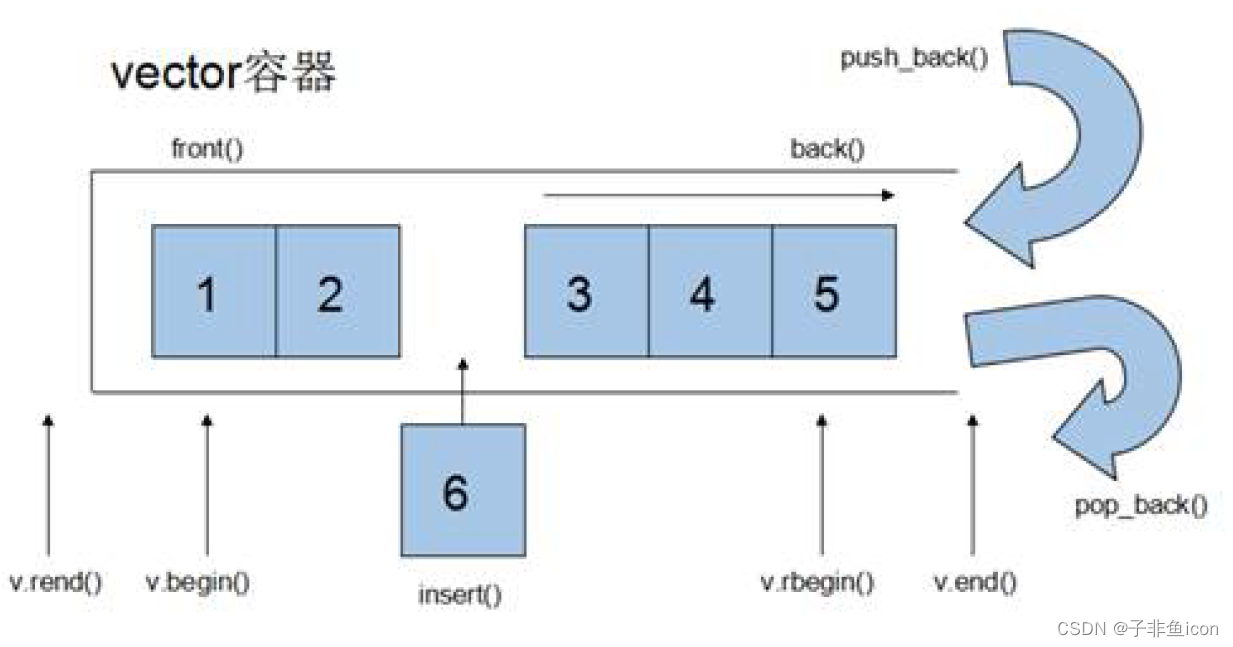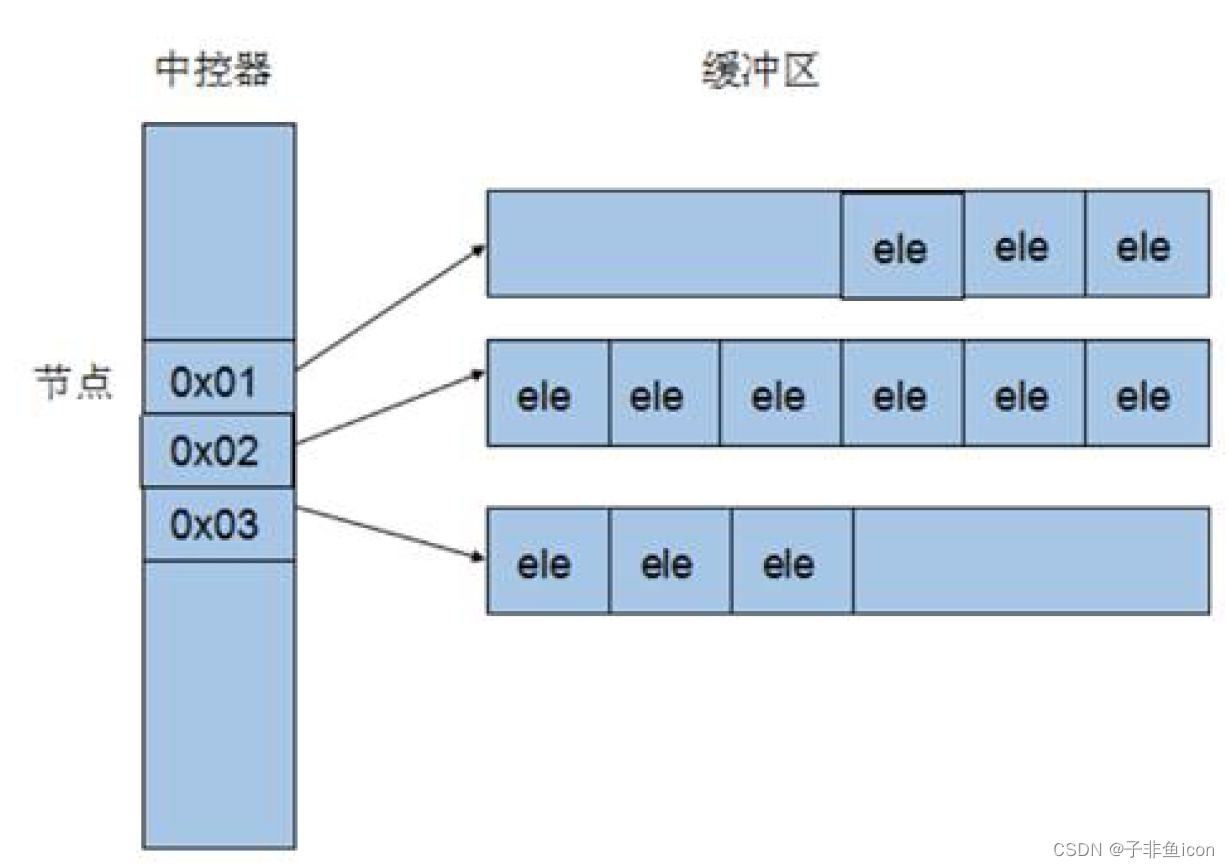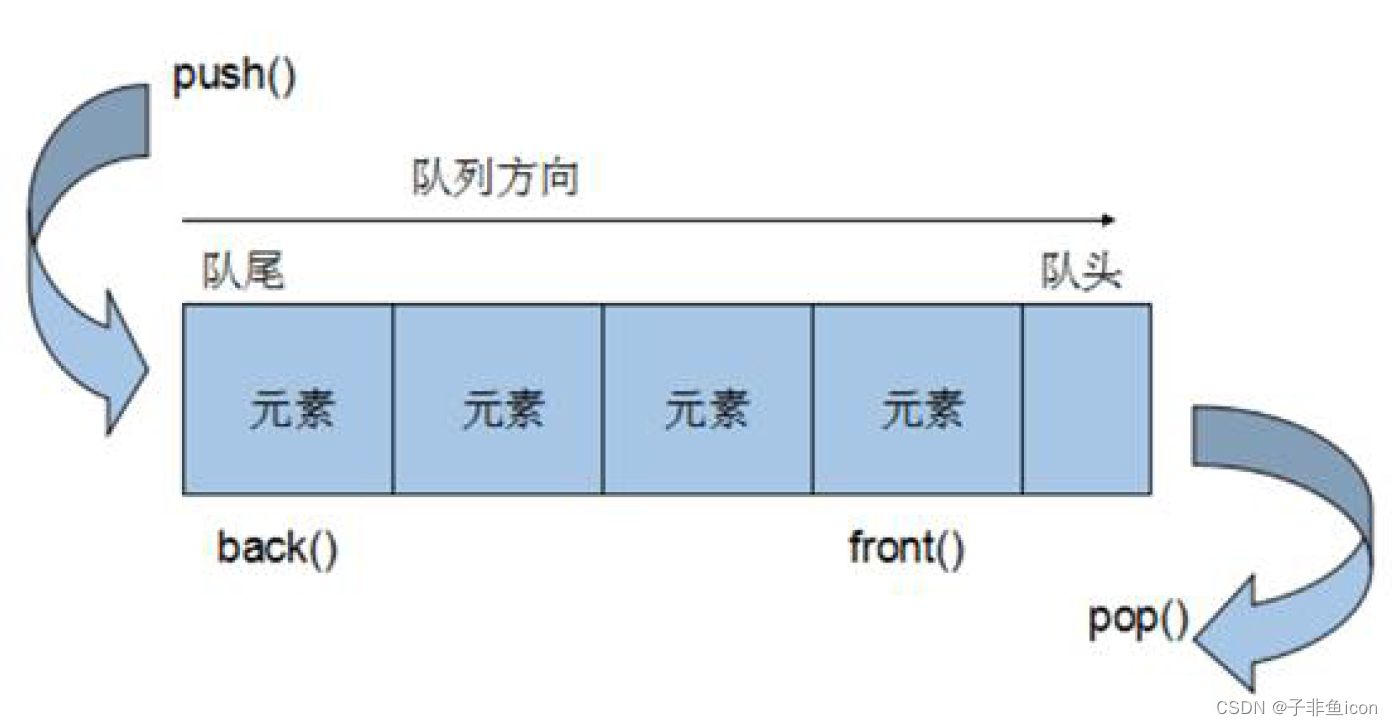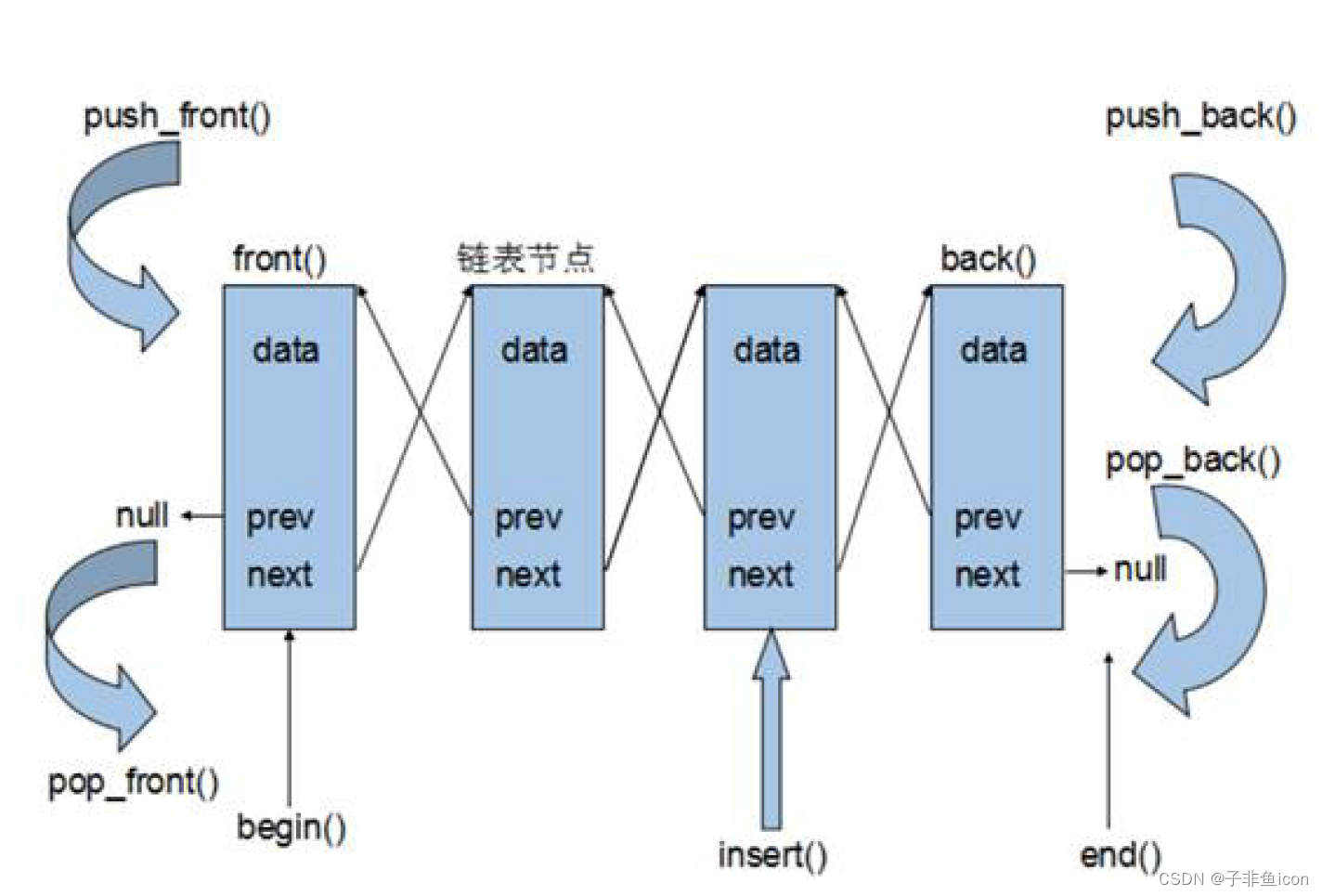C++基础学习笔记(七)——提高编程PART2

参考链接:https://www.bilibili.com/video/BV1et411b73Z/p=189&spm_id_from=pageDriver&vd_source=b4d9cee68649c8adcb1e266f7147cd5c
三、STL- 常用容器
3.1 string容器
3.1.1 string基本概念
本质:
string是C++风格的字符串,而string本质上是一个类
string和char * 区别:
char * 是一个指针
string是一个类,类内部封装了char*,管理这个字符串,是一个char*型的容器。
特点:
string 类内部封装了很多成员方法
例如:查找find,拷贝copy,删除delete 替换replace,插入insert
string管理char*所分配的内存,不用担心复制越界和取值越界等,由类内部进行负责
3.1.2 string构造函数
构造函数原型:
string(); //创建一个空的字符串 例如: string str;
string(const char* s); //使用字符串s初始化
string(const string& str); //使用一个string对象初始化另一个string对象
string(int n, char c); //使用n个字符c初始化
demo19:
#include<iostream>
#include<string>
using namespace std;//string构造函数
/*
string(); //创建一个空的字符串 例如: string str;
string(const char* s); //使用字符串s初始化
string(const string& str); //使用一个string对象初始化另一个string对象
string(int n, char c); //使用n个字符c初始化
*/
void test01()
{string s1; //默认构造const char* str = "hello world";string s2(str);cout << "s2 = " << s2 << endl;string s3(s2);cout << "s3 = " << s3 << endl;string s4(10, 'a');cout << "s4 = " << s4 << endl;
}int main()
{test01();system("pause");return 0;
}
s2 = hello world
s3 = hello world
s4 = aaaaaaaaaa
总结:string的多种构造方式没有可比性,灵活使用即可
3.1.3 string赋值操作
功能描述:
给string字符串进行赋值
赋值的函数原型:
string& operator=(const char* s); //char*类型字符串 赋值给当前的字符串
string& operator=(const string &s); //把字符串s赋给当前的字符串
string& operator=(char c); //字符赋值给当前的字符串
string& assign(const char *s); //把字符串s赋给当前的字符串
string& assign(const char *s, int n); //把字符串s的前n个字符赋给当前的字符串
string& assign(const string &s); //把字符串s赋给当前字符串
string& assign(int n, char c); //用n个字符c赋给当前字符串
demo20:
#include<iostream>
#include<string>
using namespace std;//string赋值操作void test01()
{string str1; str1 = "hello world";cout << "str1 = " << str1 << endl;string str2;str2 = str1;cout << "str2 = " << str2 << endl;string str3;str3 = 'a';cout << "str3 = " << str3 << endl;string str4;str4.assign("Hello C++");cout << "str4 = " << str4 << endl;string str5;str4.assign("Hello C++",5);cout << "str5 = " << str5 << endl;string str6;str6.assign(str5);cout << "str6 = " << str6 << endl;string str7;str7.assign(10,'w');cout << "str7 = " << str7 << endl;
}
str1 = hello world
str2 = hello world
str3 = a
str4 = Hello C++
str5 =
str6 =
str7 = wwwwwwwwww
总结:
string的赋值方式很多, operator= 这种方式是比较实用的
3.1.4 string字符串拼接
功能描述:
实现在字符串末尾拼接字符串
函数原型:
string& operator+=(const char* str); //重载+=操作符
string& operator+=(const char c); //重载+=操作符
string& operator+=(const string& str); //重载+=操作符
string& append(const char *s); //把字符串s连接到当前字符串结尾
string& append(const char *s, int n); //把字符串s的前n个字符连接到当前字符串结尾
string& append(const string &s); //同operator+=(const string& str)
string& append(const string &s, int pos, int n); //字符串s中从pos开始的n个字符连接到字符串结尾
demo21:
#include<iostream>
#include<string>
using namespace std;//string字符串拼接void test01()
{string str1 = "我";str1 += "爱玩游戏";cout << "str1 = " << str1 << endl;str1 += ':';cout << "str1 = " << str1 << endl;string str2 = "LOL DNF";str1 += str2;cout << "str1 = " << str1 << endl;string str3 = "I";str3.append(" love ");cout << "str3 = " << str3 << endl;str3.append("game abcde",4);cout << "str3 = " << str3 << endl;str3.append(str2);cout << "str3 = " << str3 << endl;str3.append(str2, 0, 3); //只截取到 LOL 参数2:从哪个位置开始截取 参数3:截取字符个数cout << "str3 = " << str3 << endl;
}
str1 = 我爱玩游戏
str1 = 我爱玩游戏:
str1 = 我爱玩游戏:LOL DNF
str3 = I love
str3 = I love game
str3 = I love gameLOL DNF
str3 = I love gameLOL DNFLOL
总结:字符串拼接的重载版本很多,初学阶段记住几种即可
3.1.5 string查找和替换
功能描述:
查找:查找指定字符串是否存在
替换:在指定的位置替换字符串
函数原型:
int find(const string& str, int pos = 0) const; //查找str第一次出现位置,从pos开始查找
int find(const char* s, int pos = 0) const; //查找s第一次出现位置,从pos开始查找
int find(const char* s, int pos, int n) const; //从pos位置查找s的前n个字符第一次位置
int find(const char c, int pos = 0) const; //查找字符c第一次出现位置
int rfind(const string& str, int pos = npos) const; //查找str最后一次位置,从pos开始查找
int rfind(const char* s, int pos = npos) const; //查找s最后一次出现位置,从pos开始查找
int rfind(const char* s, int pos, int n) const; //从pos查找s的前n个字符最后一次位置
int rfind(const char c, int pos = 0) const; //查找字符c最后一次出现位置
string& replace(int pos, int n, const string& str); //替换从pos开始n个字符为字符串str
string& replace(int pos, int n,const char* s); //替换从pos开始的n个字符为字符串s
demo22:
#include<iostream>
#include<string>
using namespace std;//string字符串查找和替换void test01()
{//查找string str1 = "abcdefgde";int pos = str1.find("de");if (pos == -1){cout << "未找到" << endl;}else{cout << "pos = " << pos << endl;}pos = str1.rfind("de");cout << "pos = " << pos << endl;}void test02()
{//替换string str1 = "abcdefgde";//从1号位置起,3个字符,替换为1111str1.replace(1, 3, "1111");cout << "str1 = " << str1 << endl;
}int main()
{test01();test02();system("pause");return 0;
}
pos = 3
pos = 7
str1 = a1111efgde
总结:
find查找是从左往后,rfind从右往左
find找到字符串后返回查找的第一个字符位置,找不到返回-1
replace在替换时,要指定从哪个位置起,多少个字符,替换成什么样的字符串
3.1.6 string字符串比较
功能描述:
字符串之间的比较
比较方式:
字符串比较是按字符的ASCII码进行对比
= 返回 0
> 返回 1
< 返回 -1
函数原型:
int compare(const string &s) const; //与字符串s比较
int compare(const char *s) const; //与字符串s比较
demo23:
#include<iostream>
#include<string>
using namespace std;//string字符串查找和替换void test01()
{string s1 = "hello";string s2 = "aello";int ret = s1.compare(s2);if (ret == 0) {cout << "s1 等于 s2" << endl;}else if (ret > 0){cout << "s1 大于 s2" << endl;}else{cout << "s1 小于 s2" << endl;}}int main()
{test01();system("pause");return 0;
}
s1 大于 s2
总结:字符串对比主要是用于比较两个字符串是否相等,判断谁大谁小的意义并不是很大
3.1.7 string字符存取
string中单个字符存取方式有两种
char& operator[](int n); //通过[]方式取字符
char& at(int n); //通过at方法获取字符
demo24:
#include<iostream>
#include<string>
using namespace std;//string字符存取void test01()
{string str = "hello world";//1.通过[]访问单个字符for (int i = 0; i < str.size(); i++){cout << str[i] << " ";}cout << endl;//2.通过at方式访问单个字符for (int i = 0; i < str.size(); i++){cout << str.at(i) << " ";}cout << endl;//字符修改str[0] = 'x';str.at(1) = 'x';cout << str << endl;
}int main()
{test01();system("pause");return 0;
}
h e l l o w o r l d
h e l l o w o r l d
xxllo world
总结:string字符串中单个字符存取有两种方式,利用 [ ] 或 at
3.1.8 string插入和删除
功能描述:
对string字符串进行插入和删除字符操作
函数原型:
string& insert(int pos, const char* s); //插入字符串
string& insert(int pos, const string& str); //插入字符串
string& insert(int pos, int n, char c); //在指定位置插入n个字符c
string& erase(int pos, int n = npos); //删除从Pos开始的n个字符
demo25:
#include<iostream>
#include<string>
using namespace std;//string字符串 插入和删除void test01()
{string str = "hello";str.insert(1, "111");cout << str << endl;str.erase(1, 3); //从1号位置开始3个字符cout << str << endl;
}int main()
{test01();system("pause");return 0;
}
h111ello
hello
总结:插入和删除的起始下标都是从0开始
3.1.9 string子串
功能描述:
从字符串中获取想要的子串
函数原型:
string substr(int pos = 0, int n = npos) const; //返回由pos开始的n个字符组成的字符串
demo26:
#include<iostream>
#include<string>
using namespace std;//string字符串 插入和删除void test01()
{string str = "abcdefg";string subStr = str.substr(1, 3);cout << "subStr = " << subStr << endl;string email = "hello@sina.com";int pos = email.find("@");string username = email.substr(0, pos);cout << "username: " << username << endl;
}int main()
{test01();system("pause");return 0;
}
subStr = bcd
username: hello
总结:灵活的运用求子串功能,可以在实际开发中获取有效的信息
3.2 vector容器
3.2.1 vector基本概念
功能:
vector数据结构和数组非常相似,也称为单端数组
vector与普通数组区别:
不同之处在于数组是静态空间,而vector可以动态扩展
动态扩展:
并不是在原空间之后续接新空间,而是找更大的内存空间,然后将原数据拷贝新空间,释放原空间

vector容器的迭代器是支持随机访问的迭代器
3.2.2 vector构造函数
功能描述:
创建vector容器
函数原型:
vector<T> v; //采用模板实现类实现,默认构造函数
vector(v.begin(), v.end()); //将v[begin(), end())区间中的元素拷贝给本身。
vector(n, elem); //构造函数将n个elem拷贝给本身。
vector(const vector &vec); //拷贝构造函数。
demo27:
#include<iostream>
#include<string>
using namespace std;
#include<vector>//vector容器构造
void printVector(vector<int>& v) {for (vector<int>::iterator it = v.begin(); it != v.end(); it++) {cout << *it << " ";}cout << endl;
}void test01()
{vector<int> v1; //默认构造 无参构造for (int i = 0; i < 10; i++){v1.push_back(i);}printVector(v1);//通过区间方式进行构造vector<int> v2(v1.begin(), v1.end());printVector(v2);//n个elem方式vector<int> v3(10, 100); //10个100printVector(v3);//拷贝构造vector<int> v4(v3);printVector(v4);
}int main()
{test01();system("pause");return 0;
}
0 1 2 3 4 5 6 7 8 9
0 1 2 3 4 5 6 7 8 9
100 100 100 100 100 100 100 100 100 100
100 100 100 100 100 100 100 100 100 100
总结:vector的多种构造方式没有可比性,灵活使用即可
3.2.3 vector赋值操作
功能描述:
给vector容器进行赋值
函数原型:
vector& operator=(const vector &vec); //重载等号操作符
assign(beg, end); //将[beg, end)区间中的数据拷贝赋值给本身。
assign(n, elem); //将n个elem拷贝赋值给本身。
demo28:
#include<iostream>
#include<string>
using namespace std;
#include<vector>//vector赋值
void printVector(vector<int>& v) {for (vector<int>::iterator it = v.begin(); it != v.end(); it++) {cout << *it << " ";}cout << endl;
}void test01()
{vector<int> v1; //无参构造for (int i = 0; i < 10; i++){v1.push_back(i);}printVector(v1);//赋值 operator=vector<int>v2;v2 = v1;printVector(v2);//assignvector<int>v3;v3.assign(v1.begin(), v1.end());printVector(v3);//n个elem方式赋值vector<int>v4;v4.assign(10, 100);printVector(v4);
}int main()
{test01();system("pause");return 0;
}
0 1 2 3 4 5 6 7 8 9
0 1 2 3 4 5 6 7 8 9
0 1 2 3 4 5 6 7 8 9
100 100 100 100 100 100 100 100 100 100
总结: vector赋值方式比较简单,使用operator=,或者assign都可以
3.2.4 vector容量和大小
功能描述:
对vector容器的容量和大小操作
函数原型:
empty(); //判断容器是否为空
capacity(); //容器的容量
size(); //返回容器中元素的个数
resize(int num); //重新指定容器的长度为num,若容器变长,则以默认值填充新位置。
//如果容器变短,则末尾超出容器长度的元素被删除。
resize(int num, elem); //重新指定容器的长度为num,若容器变长,则以elem值填充新位置。
//如果容器变短,则末尾超出容器长度的元素被删除
demo29:
#include<iostream>
#include<string>
using namespace std;
#include<vector>//vector容器的容量和大小操作
void printVector(vector<int>& v) {for (vector<int>::iterator it = v.begin(); it != v.end(); it++) {cout << *it << " ";}cout << endl;
}void test01()
{vector<int> v1; //无参构造for (int i = 0; i < 10; i++){v1.push_back(i);}printVector(v1);if (v1.empty()) //为真 代表容器为空{cout << "v1为空" << endl;}else{cout << "v1不为空" << endl;cout << "v1的容量 = " << v1.capacity() << endl;cout << "v1的大小 = " << v1.size() << endl;}//resize 重新指定大小 ,若指定的更大,默认用0填充新位置,可以利用重载版本替换默认填充v1.resize(15, 10);printVector(v1);//resize 重新指定大小 ,若指定的更小,超出部分元素被删除v1.resize(5);printVector(v1);
}int main()
{test01();system("pause");return 0;
}
0 1 2 3 4 5 6 7 8 9
v1不为空
v1的容量 = 13
v1的大小 = 10
0 1 2 3 4 5 6 7 8 9 10 10 10 10 10
0 1 2 3 4
总结:
判断是否为空 — empty
返回元素个数 — size
返回容器容量 — capacity
重新指定大小 — resize
3.2.5 vector插入和删除
功能描述:
对vector容器进行插入、删除操作
函数原型:
push_back(ele); //尾部插入元素ele
pop_back(); //删除最后一个元素
insert(const_iterator pos, ele); //迭代器指向位置pos插入元素ele
insert(const_iterator pos, int count,ele); //迭代器指向位置pos插入count个元素ele
erase(const_iterator pos); //删除迭代器指向的元素
erase(const_iterator start, const_iterator end); //删除迭代器从start到end之间的元素
clear(); //删除容器中所有元素
demo30:
#include<iostream>
#include<string>
using namespace std;
#include<vector>//vector容器的插入和删除
void printVector(vector<int>& v) {for (vector<int>::iterator it = v.begin(); it != v.end(); it++) {cout << *it << " ";}cout << endl;
}void test01()
{vector<int> v1;//尾插v1.push_back(10);v1.push_back(20);v1.push_back(30);v1.push_back(40);v1.push_back(50);printVector(v1);//尾删v1.pop_back();printVector(v1);//插入 第一个参数是迭代器v1.insert(v1.begin(), 100);printVector(v1);v1.insert(v1.begin(), 2, 1000);printVector(v1);//删除 参数也是迭代器v1.erase(v1.begin());printVector(v1);//清空//v1.erase(v1.begin(), v1.end());v1.clear();printVector(v1);
}int main()
{test01();system("pause");return 0;
}
10 20 30 40 50
10 20 30 40
100 10 20 30 40
1000 1000 100 10 20 30 40
1000 100 10 20 30 403.2.6 vector数据存取
功能描述:
对vector中的数据的存取操作
函数原型:
at(int idx); //返回索引idx所指的数据
operator[]; //返回索引idx所指的数据
front(); //返回容器中第一个数据元素
back(); //返回容器中最后一个数据元素
demo31:
#include<iostream>
#include<string>
using namespace std;
#include<vector>void test01()
{vector<int>v1;for (int i = 0; i < 10; i++){v1.push_back(i);}//利用[]方式访问数组中元素for (int i = 0; i < v1.size(); i++){cout << v1[i] << " ";}cout << endl;//利用at方式访问数组中元素for (int i = 0; i < v1.size(); i++){cout << v1.at(i) << " ";}cout << endl;cout << "v1的第一个元素为: " << v1.front() << endl;cout << "v1的最后一个元素为: " << v1.back() << endl;
}int main()
{test01();system("pause");return 0;
}
0 1 2 3 4 5 6 7 8 9
0 1 2 3 4 5 6 7 8 9
v1的第一个元素为: 0
v1的最后一个元素为: 9
总结:
除了用迭代器获取vector容器中元素,[ ]和at也可以
front返回容器第一个元素
back返回容器最后一个元素
3.2.7 vector互换容器
功能描述:
实现两个容器内元素进行互换
函数原型:
swap(vec); // 将vec与本身的元素互换
demo32:
#include<iostream>
#include<string>
using namespace std;
#include<vector>//vector容器 数据存取
void printVector(vector<int>& v) {for (vector<int>::iterator it = v.begin(); it != v.end(); it++) {cout << *it << " ";}cout << endl;
}void test01()
{vector<int>v1;for (int i = 0; i < 10; i++){v1.push_back(i);}cout << "互换前" << endl;printVector(v1);vector<int>v2;for (int i = 10; i > 0; i--){v2.push_back(i);}printVector(v2);//互换容器cout << "互换后" << endl;v1.swap(v2);printVector(v1);printVector(v2);}//实际用途 巧用swap可以收缩内存空间
void test02()
{vector<int> v;for (int i = 0; i < 100000; i++) {v.push_back(i);}cout << "v的容量为:" << v.capacity() << endl;cout << "v的大小为:" << v.size() << endl;v.resize(3); //重新指定大小cout << "v的容量为:" << v.capacity() << endl; //容量不变,浪费空间cout << "v的大小为:" << v.size() << endl;//用swap收缩内存vector<int>(v).swap(v); //匿名对象;当前行执行完毕后,立马回收cout << "v的容量为:" << v.capacity() << endl; //容量也变为3,节省空间cout << "v的大小为:" << v.size() << endl;
}int main()
{test01();test02();system("pause");return 0;
}
互换前
0 1 2 3 4 5 6 7 8 9
10 9 8 7 6 5 4 3 2 1
互换后
10 9 8 7 6 5 4 3 2 1
0 1 2 3 4 5 6 7 8 9
v的容量为:138255
v的大小为:100000
v的容量为:138255
v的大小为:3
v的容量为:3
v的大小为:3
总结:swap可以使两个容器互换,可以达到实用的收缩内存效果
3.2.8 vector预留空间
功能描述:
减少vector在动态扩展容量时的扩展次数
函数原型:
reserve(int len); //容器预留len个元素长度,预留位置不初始化,元素不可访问。
demo33:
#include<iostream>
#include<string>
using namespace std;
#include<vector>void test01()
{vector<int> v;//预留空间v.reserve(100000);int num = 0; //统计开辟的次数int* p = NULL;for (int i = 0; i < 100000; i++) {v.push_back(i);if (p != &v[0]) //每次新开辟内存时,首地址会发生变化{p = &v[0];num++;}}cout << "num:" << num << endl; //30次}int main()
{test01();system("pause");return 0;
}
num:1
总结:如果数据量较大,可以一开始利用reserve预留空间
3.3 deque容器
3.3.1 deque容器基本概念
功能:
双端数组,可以对头端进行插入删除操作
deque与vector区别:
vector对于头部的插入删除效率低,数据量越大,效率越低
deque相对而言,对头部的插入删除速度回比vector快
vector访问元素时的速度会比deque快,这和两者内部实现有关

deque内部工作原理:
deque内部有个中控器,维护每段缓冲区中的内容,缓冲区中存放真实数据
中控器维护的是每个缓冲区的地址,使得使用deque时像一片连续的内存空间

deque容器的迭代器也是支持随机访问的
3.3.2 deque构造函数
功能描述:
deque容器构造
函数原型:
deque<T> deqT; //默认构造形式
deque(beg, end); //构造函数将[beg, end)区间中的元素拷贝给本身。
deque(n, elem); //构造函数将n个elem拷贝给本身。
deque(const deque &deq); //拷贝构造函数
demo34:
#include<iostream>
#include<string>
using namespace std;
#include<deque>//deque容器构造函数
void printDeque(const deque<int>& d) //只读不可以修改
{for (deque<int>::const_iterator it = d.begin(); it != d.end(); it++){//*it = 100; //防止被这样修改cout << *it << " ";}cout << endl;
}void test01()
{deque<int>d1;for (int i = 0; i < 10; i++){d1.push_back(i);}printDeque(d1);deque<int>d2(d1.begin(), d1.end());printDeque(d2);deque<int>d3(10, 100);printDeque(d3);deque<int>d4(d3);printDeque(d4);
}int main()
{test01();system("pause");return 0;
}0 1 2 3 4 5 6 7 8 9
0 1 2 3 4 5 6 7 8 9
100 100 100 100 100 100 100 100 100 100
100 100 100 100 100 100 100 100 100 100
总结:deque容器和vector容器的构造方式几乎一致,灵活使用即可
3.3.3 deque赋值操作
功能描述:
给deque容器进行赋值
函数原型:
deque& operator=(const deque &deq); //重载等号操作符
assign(beg, end); //将[beg, end)区间中的数据拷贝赋值给本身。
assign(n, elem); //将n个elem拷贝赋值给本身。
demo35:
#include<iostream>
#include<string>
using namespace std;
#include<deque>//deque容器赋值操作
void printDeque(const deque<int>& d) //只读不可以修改
{for (deque<int>::const_iterator it = d.begin(); it != d.end(); it++){//*it = 100; //防止被这样修改cout << *it << " ";}cout << endl;
}void test01()
{deque<int> d1;for (int i = 0; i < 10; i++){d1.push_back(i);}printDeque(d1);deque<int>d2;d2 = d1;printDeque(d2);deque<int>d3;d3.assign(d1.begin(), d1.end());printDeque(d3);deque<int>d4;d4.assign(10, 100);printDeque(d4);
}int main()
{test01();system("pause");return 0;
}
0 1 2 3 4 5 6 7 8 9
0 1 2 3 4 5 6 7 8 9
0 1 2 3 4 5 6 7 8 9
100 100 100 100 100 100 100 100 100 100
总结:deque赋值操作也与vector相同,需熟练掌握
3.3.4 deque大小操作
功能描述:
对deque容器的大小进行操作
函数原型:
deque.empty(); //判断容器是否为空
deque.size(); //返回容器中元素的个数
deque.resize(num); //重新指定容器的长度为num,若容器变长,则以默认值填充新位置。
//如果容器变短,则末尾超出容器长度的元素被删除。
deque.resize(num, elem); //重新指定容器的长度为num,若容器变长,则以elem值填充新位置。
//如果容器变短,则末尾超出容器长度的元素被删除。
demo36:
#include<iostream>
#include<string>
using namespace std;
#include<deque>//deque容器赋值操作
void printDeque(const deque<int>& d) //只读不可以修改
{for (deque<int>::const_iterator it = d.begin(); it != d.end(); it++){//*it = 100; //防止被这样修改cout << *it << " ";}cout << endl;
}void test01()
{deque<int> d1;for (int i = 0; i < 10; i++){d1.push_back(i);}printDeque(d1);//判断容器是否为空if (d1.empty()) {cout << "d1为空!" << endl;}else {cout << "d1不为空!" << endl;//统计大小cout << "d1的大小为:" << d1.size() << endl;//deque容器没有容量概念}//重新指定大小d1.resize(15, 1);printDeque(d1);d1.resize(5);printDeque(d1);
}int main()
{test01();system("pause");return 0;
}
0 1 2 3 4 5 6 7 8 9
d1不为空!
d1的大小为:10
0 1 2 3 4 5 6 7 8 9 1 1 1 1 1
0 1 2 3 4
总结:
deque没有容量的概念
判断是否为空 — empty
返回元素个数 — size
重新指定个数 — resize
3.3.5 deque 插入和删除
功能描述:
向deque容器中插入和删除数据
函数原型:
两端插入操作:
push_back(elem); //在容器尾部添加一个数据
push_front(elem); //在容器头部插入一个数据
pop_back(); //删除容器最后一个数据
pop_front(); //删除容器第一个数据
指定位置操作:
insert(pos,elem); //在pos位置插入一个elem元素的拷贝,返回新数据的位置。
insert(pos,n,elem); //在pos位置插入n个elem数据,无返回值。
insert(pos,beg,end); //在pos位置插入[beg,end)区间的数据,无返回值。
clear(); //清空容器的所有数据
erase(beg,end); //删除[beg,end)区间的数据,返回下一个数据的位置。
erase(pos); //删除pos位置的数据,返回下一个数据的位置。
demo37:
#include<iostream>
#include<string>
using namespace std;
#include<deque>//deque容器插入和删除
void printDeque(const deque<int>& d) //只读不可以修改
{for (deque<int>::const_iterator it = d.begin(); it != d.end(); it++){//*it = 100; //防止被这样修改cout << *it << " ";}cout << endl;
}void test01()
{deque<int> d;//尾插d.push_back(10);d.push_back(20);printDeque(d);//头插d.push_front(100);d.push_front(200);printDeque(d);//尾删d.pop_back();printDeque(d);//头删d.pop_front();printDeque(d);
}//插入
void test02()
{deque<int> d;d.push_back(10);d.push_back(20);d.push_front(100);d.push_front(200);printDeque(d);//insert插入d.insert(d.begin(), 1000);printDeque(d);d.insert(d.begin(), 2, 10000);printDeque(d);deque<int>d2;d2.push_back(1);d2.push_back(2);d2.push_back(3);d.insert(d.begin(), d2.begin(), d2.end());printDeque(d);
}//删除
void test03()
{deque<int> d;d.push_back(10);d.push_back(20);d.push_front(100);d.push_front(200);printDeque(d);d.erase(d.begin());printDeque(d);d.erase(d.begin(), d.end());d.clear();printDeque(d);
}int main()
{test01();cout << "------------" << endl;test02();cout << "------------" << endl;test03();system("pause");return 0;
}10 20
200 100 10 20
200 100 10
100 10
------------
200 100 10 20
1000 200 100 10 20
10000 10000 1000 200 100 10 20
1 2 3 10000 10000 1000 200 100 10 20
------------
200 100 10 20
100 10 20总结:
插入和删除提供的位置是迭代器!
尾插 — push_back
尾删 — pop_back
头插 — push_front
头删 — pop_front
3.3.6 deque 数据存取
功能描述:
对deque 中的数据的存取操作
函数原型:
at(int idx); //返回索引idx所指的数据
operator[]; //返回索引idx所指的数据
front(); //返回容器中第一个数据元素
back(); //返回容器中最后一个数据元素
demo38:
#include<iostream>
#include<string>
using namespace std;
#include<deque>//deque容器数据存取
void printDeque(const deque<int>& d) //只读不可以修改
{for (deque<int>::const_iterator it = d.begin(); it != d.end(); it++){//*it = 100; //防止被这样修改cout << *it << " ";}cout << endl;
}void test01()
{deque<int> d;d.push_back(10);d.push_back(20);d.push_front(100);d.push_front(200);for (int i = 0; i < d.size(); i++) {cout << d[i] << " ";}cout << endl;for (int i = 0; i < d.size(); i++) {cout << d.at(i) << " ";}cout << endl;cout << "front:" << d.front() << endl;cout << "back:" << d.back() << endl;
}int main()
{test01();system("pause");return 0;
}200 100 10 20
200 100 10 20
front:200
back:20
总结:
除了用迭代器获取deque容器中元素,[ ]和at也可以
front返回容器第一个元素
back返回容器最后一个元素
3.3.7 deque 排序
功能描述:
利用算法实现对deque容器进行排序
算法:
sort(iterator beg, iterator end) //对beg和end区间内元素进行排序
demo39:
#include<iostream>
#include<string>
using namespace std;
#include<deque>
#include <algorithm>//deque容器排序
void printDeque(const deque<int>& d) //只读不可以修改
{for (deque<int>::const_iterator it = d.begin(); it != d.end(); it++){//*it = 100; //防止被这样修改cout << *it << " ";}cout << endl;
}void test01()
{deque<int> d;d.push_back(10);d.push_back(20);d.push_back(30);d.push_front(100);d.push_front(200);d.push_front(300);printDeque(d);//排序,默认排序规则 从小到大升序//对于支持随机访问的迭代器的容器,都可以利用sort算法直接对其进行排序//vector容器也可以利用sort进行排序sort(d.begin(), d.end());printDeque(d);
}int main()
{test01();system("pause");return 0;
}300 200 100 10 20 30
10 20 30 100 200 300
总结:sort算法非常实用,使用时包含头文件 algorithm即可
3.4 案例-评委打分
3.4.1 案例描述
有5名选手:选手ABCDE,10个评委分别对每一名选手打分,去除最高分,去除评委中最低分,取平均分。
3.4.2 实现步骤
- 创建五名选手,放到vector中
- 遍历vector容器,取出来每一个选手,执行for循环,可以把10个评分打分存到deque容器中
- sort算法对deque容器中分数排序,去除最高和最低分
- deque容器遍历一遍,累加总分
- 获取平均分
demo40:
#include<iostream>
#include<string>
using namespace std;
#include<vector>
#include<deque>
#include <algorithm>
#include<ctime>//创建选手类
class Person
{
public:Person(string name, int score){this->m_Name = name;this->m_Score = score;}string m_Name; //姓名int m_Score; //分数
};void createPerson(vector<Person>& v)
{string nameSeed = "ABCDE";for (int i = 0; i < 5; i++){string name = "选手";name += nameSeed[i];int score = 0;Person p(name, score);v.push_back(p);}}//打分
void setScore(vector<Person>& v)
{for (vector<Person>::iterator it = v.begin(); it != v.end(); it++){//将评委的分数 放入到deque容器中deque<int>d;for (int i = 0; i < 10; i++){int score = rand() % 41 + 60; //rand() % 41表示0~40的随机数d.push_back(score);}//排序sort(d.begin(), d.end());//去除最高分和最低分d.pop_back();d.pop_front();//printDeque(d);//遍历deque容器,累加总分int sum = 0;for (int j =0; j<d.size(); j++){sum += d[j];}//获取平均分double meanScore = sum / d.size();//将平均分赋值给选手(*it).m_Score = meanScore;}
}//显示分数
void showScore(const vector<Person>& v)
{for (vector<Person>::const_iterator it = v.begin(); it != v.end(); it++){cout << "姓名: " << it->m_Name << " 分数: " << it->m_Score << endl;}
}int main()
{//随机数种子srand((unsigned int)time(NULL));//创建五名选手//创建vector容器vector<Person>v;createPerson(v); 测试//for (vector<Person>::iterator it = v.begin(); it != v.end(); it++)//{// cout << "姓名: "<< it->m_Name << " 分数: " << it->m_Score << endl; //(*it).m_Name//}//打分setScore(v);//显示最后分数showScore(v);system("pause");return 0;
}
姓名: 选手A 分数: 81
姓名: 选手B 分数: 88
姓名: 选手C 分数: 84
姓名: 选手D 分数: 75
姓名: 选手E 分数: 80
总结: 选取不同的容器操作数据,可以提升代码的效率
3.5 stack容器
3.5.1 stack 基本概念
概念:stack是一种先进后出(First In Last Out,FILO)的数据结构,它只有一个出口

栈中只有顶端的元素才可以被外界使用,因此栈不允许有遍历行为
栈中进入数据称为 — 入栈 push
栈中弹出数据称为 — 出栈 pop

3.5.2 stack 常用接口
功能描述:栈容器常用的对外接口
构造函数:
stack<T> stk; //stack采用模板类实现, stack对象的默认构造形式
stack(const stack &stk); //拷贝构造函数
赋值操作:
stack& operator=(const stack &stk); //重载等号操作符
数据存取:
push(elem); //向栈顶添加元素
pop(); //从栈顶移除第一个元素
top(); //返回栈顶元素
大小操作:
empty(); //判断堆栈是否为空
size(); //返回栈的大小
demo41:
#include<iostream>
#include<string>
using namespace std;
#include<stack>//栈stack容器
void test01()
{//创建栈容器 栈容器必须符合先进后出stack<int> s;//向栈中添加元素,叫做 压栈 入栈s.push(10);s.push(20);s.push(30);s.push(40);cout << "栈的大小为:" << s.size() << endl;//只要栈不为空,查看栈顶,并且执行出栈操作while (!s.empty()) {//输出栈顶元素cout << "栈顶元素为: " << s.top() << endl;//弹出栈顶元素s.pop();}cout << "栈的大小为:" << s.size() << endl;
}int main()
{test01();system("pause");return 0;
}
栈的大小为:4
栈顶元素为: 40
栈顶元素为: 30
栈顶元素为: 20
栈顶元素为: 10
栈的大小为:0
总结:
入栈 — push
出栈 — pop
返回栈顶 — top
判断栈是否为空 — empty
返回栈大小 — size
3.6 queue 容器
3.6.1 queue 基本概念
概念:Queue是一种先进先出(First In First Out,FIFO)的数据结构,它有两个出口

队列容器允许从一端新增元素,从另一端移除元素
队列中只有队头和队尾才可以被外界使用,因此队列不允许有遍历行为
队列中进数据称为 — 入队 push
队列中出数据称为 — 出队 pop

3.6.2 queue 常用接口
功能描述:栈容器常用的对外接口
构造函数:
queue<T> que; //queue采用模板类实现,queue对象的默认构造形式
queue(const queue &que); //拷贝构造函数
赋值操作:
queue& operator=(const queue &que); //重载等号操作符
数据存取:
push(elem); //往队尾添加元素
pop(); //从队头移除第一个元素
back(); //返回最后一个元素
front(); //返回第一个元素
大小操作:
empty(); //判断堆栈是否为空
size(); //返回栈的大小
demo42:
#include<iostream>
#include<string>
using namespace std;
#include<queue>class Person
{
public:Person(string name, int age){this->m_Name = name;this->m_Age = age;}string m_Name;int m_Age;
};//队列queue容器
void test01()
{//创建队列queue<Person> q;//准备数据Person p1("唐僧", 30);Person p2("孙悟空", 1000);Person p3("猪八戒", 900);Person p4("沙僧", 800);//向队列中添加元素 入队操作q.push(p1);q.push(p2);q.push(p3);q.push(p4);cout << "队列大小为:" << q.size() << endl;//队列不提供迭代器,更不支持随机访问while (!q.empty()) {//输出队头元素cout << "队头元素-- 姓名: " << q.front().m_Name<< " 年龄: " << q.front().m_Age << endl;cout << "队尾元素-- 姓名: " << q.back().m_Name<< " 年龄: " << q.back().m_Age << endl;cout << endl;//弹出队头元素q.pop();}cout << "队列大小为:" << q.size() << endl;
}int main()
{test01();system("pause");return 0;
}
队列大小为:4
队头元素-- 姓名: 唐僧 年龄: 30
队尾元素-- 姓名: 沙僧 年龄: 800队头元素-- 姓名: 孙悟空 年龄: 1000
队尾元素-- 姓名: 沙僧 年龄: 800队头元素-- 姓名: 猪八戒 年龄: 900
队尾元素-- 姓名: 沙僧 年龄: 800队头元素-- 姓名: 沙僧 年龄: 800
队尾元素-- 姓名: 沙僧 年龄: 800队列大小为:0
3.7 list容器
3.7.1 list基本概念
功能:将数据进行链式存储
链表(list)是一种物理存储单元上非连续的存储结构,数据元素的逻辑顺序是通过链表中的指针链接实现的
链表的组成:链表由一系列结点组成
结点的组成:一个是存储数据元素的数据域,另一个是存储下一个结点地址的指针域
STL中的链表是一个双向循环链表

由于链表的存储方式并不是连续的内存空间,因此链表list中的迭代器只支持前移和后移,属于双向迭代器
list的优点:
采用动态存储分配,不会造成内存浪费和溢出
链表执行插入和删除操作十分方便,修改指针即可,不需要移动大量元素
list的缺点:
链表灵活,但是空间(指针域) 和 时间(遍历)额外耗费较大
List有一个重要的性质,插入操作和删除操作都不会造成原有list迭代器的失效,这在vector是不成立的。
总结:STL中List和vector是两个最常被使用的容器,各有优缺点
3.7.2 list构造函数
功能描述:
创建list容器
函数原型:
list<T> lst; //list采用采用模板类实现,对象的默认构造形式:
list(beg,end); //构造函数将[beg, end)区间中的元素拷贝给本身。
list(n,elem); //构造函数将n个elem拷贝给本身。
list(const list &lst); //拷贝构造函数。
demo43:
#include<iostream>
#include<string>
using namespace std;
#include<list>void printList(const list<int>& L) {for (list<int>::const_iterator it = L.begin(); it != L.end(); it++) {cout << *it << " ";}cout << endl;
}//list容器构造函数
void test01()
{//创建list容器list<int>L1; //默认构造//添加数据L1.push_back(10);L1.push_back(20);L1.push_back(30);L1.push_back(40);printList(L1);//区间方式构造list<int>L2(L1.begin(), L1.end());printList(L2);//拷贝构造list<int>L3(L2);printList(L3);//n个elemlist<int>L4(10, 1000);printList(L4);
}int main()
{test01();system("pause");return 0;
}
10 20 30 40
10 20 30 40
10 20 30 40
1000 1000 1000 1000 1000 1000 1000 1000 1000 1000
总结:list构造方式同其他几个STL常用容器,熟练掌握即可
3.7.3 list 赋值和交换
功能描述:
给list容器进行赋值,以及交换list容器
函数原型:
assign(beg, end); //将[beg, end)区间中的数据拷贝赋值给本身。
assign(n, elem); //将n个elem拷贝赋值给本身。
list& operator=(const list &lst); //重载等号操作符
swap(lst); //将lst与本身的元素互换。
demo44:
#include<iostream>
#include<string>
using namespace std;
#include<list>void printList(const list<int>& L) {for (list<int>::const_iterator it = L.begin(); it != L.end(); it++) {cout << *it << " ";}cout << endl;
}//list容器赋值和交换
void test01()
{//创建list容器list<int>L1; //默认构造//添加数据L1.push_back(10);L1.push_back(20);L1.push_back(30);L1.push_back(40);printList(L1);//赋值list<int>L2;L2 = L1; //operator=printList(L2);list<int>L3;L3.assign(L2.begin(), L2.end());printList(L3);//n个elemlist<int>L4;L4.assign(10, 100);printList(L4);
}void test02()
{list<int>L1;L1.push_back(10);L1.push_back(20);L1.push_back(30);L1.push_back(40);list<int>L2;L2.assign(10, 100);cout << "交换前: " << endl;printList(L1);printList(L2);cout << endl;L1.swap(L2);cout << "交换后: " << endl;printList(L1);printList(L2);
}int main()
{//test01();test02();system("pause");return 0;
}交换前:
10 20 30 40
100 100 100 100 100 100 100 100 100 100交换后:
100 100 100 100 100 100 100 100 100 100
10 20 30 40
总结:list赋值和交换操作能够灵活运用即可
3.7.4 list 大小操作
功能描述:
对list容器的大小进行操作
函数原型:
size(); //返回容器中元素的个数
empty(); //判断容器是否为空
resize(num); //重新指定容器的长度为num,若容器变长,则以默认值填充新位置。
//如果容器变短,则末尾超出容器长度的元素被删除。
resize(num, elem); //重新指定容器的长度为num,若容器变长,则以elem值填充新位置。
//如果容器变短,则末尾超出容器长度的元素被删除。
demo45:
#include<iostream>
#include<string>
using namespace std;
#include<list>void printList(const list<int>& L) {for (list<int>::const_iterator it = L.begin(); it != L.end(); it++) {cout << *it << " ";}cout << endl;
}//list容器赋值和交换
void test01()
{//创建list容器list<int>L1; //默认构造//添加数据L1.push_back(10);L1.push_back(20);L1.push_back(30);L1.push_back(40);printList(L1);if (L1.empty()){cout << "L1为空" << endl;}else{cout << "L1不为空" << endl;cout << "L1的元素个数为: " << L1.size() << endl;}//重新指定大小L1.resize(10); //L1.resize(10,100000)printList(L1);L1.resize(2);printList(L1);
}int main()
{test01();system("pause");return 0;
}
10 20 30 40
L1不为空
L1的元素个数为: 4
10 20 30 40 0 0 0 0 0 0
10 20
总结:
判断是否为空 — empty
返回元素个数 — size
重新指定个数 — resize
3.7.5 list 插入和删除
功能描述:
对list容器进行数据的插入和删除
函数原型:
push_back(elem);//在容器尾部加入一个元素
pop_back();//删除容器中最后一个元素
push_front(elem);//在容器开头插入一个元素
pop_front();//从容器开头移除第一个元素
insert(pos,elem);//在pos位置插elem元素的拷贝,返回新数据的位置。
insert(pos,n,elem);//在pos位置插入n个elem数据,无返回值。
insert(pos,beg,end);//在pos位置插入[beg,end)区间的数据,无返回值。
clear();//移除容器的所有数据
erase(beg,end);//删除[beg,end)区间的数据,返回下一个数据的位置。
erase(pos);//删除pos位置的数据,返回下一个数据的位置。
remove(elem);//删除容器中所有与elem值匹配的元素。
demo46:
#include<iostream>
#include<string>
using namespace std;
#include<list>void printList(const list<int>& L) {for (list<int>::const_iterator it = L.begin(); it != L.end(); it++) {cout << *it << " ";}cout << endl;
}//list容器赋值和交换
void test01()
{list<int> L;//尾插L.push_back(10);L.push_back(20);L.push_back(30);//头插L.push_front(100);L.push_front(200);L.push_front(300);printList(L);//尾删L.pop_back();printList(L);//头删L.pop_front();printList(L);//插入list<int>::iterator it = L.begin(); //先准备一个迭代器L.insert(++it, 1000);printList(L);//删除it = L.begin(); //重新指定位置L.erase(++it);printList(L);//移除L.push_back(10000);L.push_back(10000);L.push_back(10000);printList(L);L.remove(10000);printList(L);//清空L.clear();printList(L);}int main()
{test01();system("pause");return 0;
}
300 200 100 10 20 30
300 200 100 10 20
200 100 10 20
200 1000 100 10 20
200 100 10 20
200 100 10 20 10000 10000 10000
200 100 10 203.7.6 list 数据存取
功能描述:
对list容器中数据进行存取
函数原型:
front(); //返回第一个元素。
back(); //返回最后一个元素。
demo47:
#include<iostream>
#include<string>
using namespace std;
#include<list>void printList(const list<int>& L) {for (list<int>::const_iterator it = L.begin(); it != L.end(); it++) {cout << *it << " ";}cout << endl;
}void test01()
{list<int>L1;L1.push_back(10);L1.push_back(20);L1.push_back(30);L1.push_back(40);//cout << L1.at(0) << endl;//错误 不支持at访问数据//cout << L1[0] << endl; //错误 不支持[]方式访问数据//原因是list本质链表,不是用连续线性空间存储数据,迭代器也是不支持随机访问的cout << "第一个元素为: " << L1.front() << endl;cout << "最后一个元素为: " << L1.back() << endl;//list容器的迭代器是双向迭代器,不支持随机访问list<int>::iterator it = L1.begin();//it = it + 1;//错误,不可以跳跃访问,即使是+1it++; // ++和--是可以的it--; //也能--,说明是双向的}int main()
{test01();system("pause");return 0;
}
第一个元素为: 10
最后一个元素为: 40
总结:
list容器中不可以通过[]或者at方式访问数据
返回第一个元素 — front
返回最后一个元素 — back
3.7.7 list 反转和排序
功能描述:
将容器中的元素反转,以及将容器中的数据进行排序
函数原型:
reverse(); //反转链表
sort(); //链表排序
demo48:
#include<iostream>
#include<string>
using namespace std;
#include<list>void printList(const list<int>& L) {for (list<int>::const_iterator it = L.begin(); it != L.end(); it++) {cout << *it << " ";}cout << endl;
}//用于排序的仿函数
bool myCompare(int val1, int val2)
{return val1 > val2; //降序,就让第一个数>第二个数
}
//反转和排序
void test01()
{list<int> L;L.push_back(90);L.push_back(30);L.push_back(20);L.push_back(70);printList(L);//反转容器的元素L.reverse();printList(L);//排序// 所有不支持随机访问迭代器的容器,不可以用标准算法//不支持随机访问迭代器的容器,内部会提供对应一些算法 ; 成员函数//sort(L1.begin(),L1.end());L.sort(); //默认的排序规则 从小到大printList(L);L.sort(myCompare); //仿函数;指定规则,从大到小printList(L);
}int main()
{test01();system("pause");return 0;
}
90 30 20 70
70 20 30 90
20 30 70 90
90 70 30 20
总结:
反转 — reverse
排序 — sort (成员函数)
3.7.8 排序案例
案例描述:将Person自定义数据类型进行排序,Person中属性有姓名、年龄、身高
排序规则:按照年龄进行升序,如果年龄相同按照身高进行降序
demo49:
#include<iostream>
#include<string>
using namespace std;
#include<list>class Person
{
public:Person(string name, int age, int height){this->m_Name = name;this->m_Age = age;this->m_Height = height;}string m_Name;int m_Age;int m_Height;
};//打印输出
void printList(const list<Person>& L) {for (list<Person>::const_iterator it = L.begin(); it != L.end(); it++) {cout << "姓名:"<<(*it).m_Name << " 年龄:"<<(*it).m_Age << " 身高:"<<(*it).m_Height << endl;}
}//仿函数用以指定排序规则
bool myCompare(Person &p1,Person &p2)
{if (p1.m_Age == p2.m_Age){//年龄相同,按照身高降序return p1.m_Height > p2.m_Height;}else{return p1.m_Age < p2.m_Age; //按照年龄升序}
}//排序
void sortList(list<Person>& L)
{L.sort(myCompare);
}int main()
{//创建几个人Person p1("张三", 28, 174);Person p2("李四", 14, 165);Person p3("王五", 25, 180);Person p4("小六", 32, 185);Person p5("七友", 25, 176);//创建list容器list<Person> L;L.push_back(p1);L.push_back(p2);L.push_back(p3);L.push_back(p4);L.push_back(p5);printList(L);cout << "--------------------" << endl;//排序sortList(L);printList(L);system("pause");return 0;
}姓名:张三 年龄:28 身高:174
姓名:李四 年龄:14 身高:165
姓名:王五 年龄:25 身高:180
姓名:小六 年龄:32 身高:185
姓名:七友 年龄:25 身高:176
--------------------
姓名:李四 年龄:14 身高:165
姓名:王五 年龄:25 身高:180
姓名:七友 年龄:25 身高:176
姓名:张三 年龄:28 身高:174
姓名:小六 年龄:32 身高:185
总结:
对于自定义数据类型,必须要指定排序规则,否则编译器不知道如何进行排序
高级排序只是在排序规则上再进行一次逻辑规则制定,并不复杂
3.8 set/ multiset 容器
3.8.1 set基本概念
简介:
所有元素都会在插入时自动被排序
本质:
set/multiset属于关联式容器,底层结构是用二叉树实现。
set和multiset区别:
set不允许容器中有重复的元素
multiset允许容器中有重复的元素
3.8.2 set构造和赋值
功能描述:创建set容器以及赋值
构造:
set<T> st; //默认构造函数:
set(const set &st); //拷贝构造函数
赋值:
set& operator=(const set &st); //重载等号操作符
demo50:
#include<iostream>
#include<string>
using namespace std;
#include<set>void printSet(set<int>& s)
{for (set<int>::iterator it = s.begin(); it != s.end(); it++){cout << *it << " ";}cout << endl;
}void test01()
{set<int> s1;//插入数据,只有insert方式s1.insert(10);s1.insert(40);s1.insert(30);s1.insert(20);s1.insert(30);//set容器特点:所有元素插入时候自动被排序//set容器不允许插入重复值printSet(s1);//拷贝构造set<int>s2(s1);printSet(s2);//赋值set<int>s3;s3 = s2;printSet(s3);
}int main()
{test01();system("pause");return 0;
}
10 20 30 40
10 20 30 40
10 20 30 40
总结:
set容器插入数据时用insert
set容器插入数据的数据会自动排序
3.8.3 set大小和交换
功能描述:
统计set容器大小以及交换set容器
函数原型:
size(); //返回容器中元素的数目
empty(); //判断容器是否为空
swap(st); //交换两个集合容器
demo51:
#include<iostream>
#include<string>
using namespace std;
#include<set>void printSet(set<int>& s)
{for (set<int>::iterator it = s.begin(); it != s.end(); it++){cout << *it << " ";}cout << endl;
}//大小
void test01()
{set<int> s1;s1.insert(10);s1.insert(30);s1.insert(20);s1.insert(40);printSet(s1);if (s1.empty()){cout << "s1为空" << endl;}else{cout << "s1不为空" << endl;cout << "s1的大小为: " << s1.size() << endl;}
}
//交换
void test02()
{set<int> s1;s1.insert(10);s1.insert(30);s1.insert(20);s1.insert(40);set<int> s2;s2.insert(100);s2.insert(300);s2.insert(200);s2.insert(400);cout << "交换前" << endl;printSet(s1);printSet(s2);cout << endl;cout << "交换后" << endl;s1.swap(s2);printSet(s1);printSet(s2);
}int main()
{test01();test02();system("pause");return 0;
}
10 20 30 40
s1不为空
s1的大小为: 4
交换前
10 20 30 40
100 200 300 400交换后
100 200 300 400
10 20 30 40
总结:
统计大小 — size
判断是否为空 — empty
交换容器 — swap
3.8.4 set插入和删除
功能描述:
set容器进行插入数据和删除数据
函数原型:
insert(elem); //在容器中插入元素。
clear(); //清除所有元素
erase(pos); //删除pos迭代器所指的元素,返回下一个元素的迭代器。
erase(beg, end); //删除区间[beg,end)的所有元素 ,返回下一个元素的迭代器。
erase(elem); //删除容器中值为elem的元素。
demo52:
#include<iostream>
#include<string>
using namespace std;
#include<set>void printSet(set<int>& s)
{for (set<int>::iterator it = s.begin(); it != s.end(); it++){cout << *it << " ";}cout << endl;
}void test01()
{set<int> s1;//插入s1.insert(10);s1.insert(30);s1.insert(20);s1.insert(40);printSet(s1);//删除s1.erase(s1.begin());printSet(s1);s1.erase(30);printSet(s1);//清空//s1.erase(s1.begin(), s1.end());s1.clear();printSet(s1);
}int main()
{test01();system("pause");return 0;
}
10 20 30 40
20 30 40
20 403.8.5 set查找和统计
功能描述:
对set容器进行查找数据以及统计数据
函数原型:
find(key); //查找key是否存在,若存在,返回该键的元素的迭代器;若不存在,返回set.end();
count(key); //统计key的元素个数
demo53:
#include<iostream>
#include<string>
using namespace std;
#include<set>//set容器查找和统计
void printSet(set<int>& s)
{for (set<int>::iterator it = s.begin(); it != s.end(); it++){cout << *it << " ";}cout << endl;
}void test01()
{set<int> s1;//插入s1.insert(10);s1.insert(30);s1.insert(30);s1.insert(30);s1.insert(20);s1.insert(40);printSet(s1);//查找 用迭代器接受set<int>::iterator pos = s1.find(30);if (pos != s1.end()){cout << "找到了元素 : " << *pos << endl;}else{cout << "未找到元素" << endl;}//统计int num = s1.count(30);//对于set而言,统计结果要么是0,要么是1cout << "num = " << num << endl;
}int main()
{test01();system("pause");return 0;
}
10 20 30 40
找到了元素 : 30
num = 1
总结:
查找 — find (返回的是迭代器)
统计 — count (对于set,结果为0或者1)
3.8.6 set和multiset区别
学习目标:
掌握set和multiset的区别
区别:
set不可以插入重复数据,而multiset可以
set插入数据的同时会返回插入结果,表示插入是否成功
multiset不会检测数据,因此可以插入重复数据
demo54:
#include<iostream>
#include<string>
using namespace std;
#include<set>//set容器和multiset区别
void printSet(set<int>& s)
{for (set<int>::iterator it = s.begin(); it != s.end(); it++){cout << *it << " ";}cout << endl;
}void test01()
{set<int> s;pair<set<int>::iterator, bool> ret = s.insert(10); //对组,判断是否插入成功if (ret.second) {cout << "第一次插入成功!" << endl;}else {cout << "第一次插入失败!" << endl;}ret = s.insert(10);if (ret.second) {cout << "第二次插入成功!" << endl;}else {cout << "第二次插入失败!" << endl;}//multiset 允许插入重复值multiset<int> ms;ms.insert(10);ms.insert(10);for (multiset<int>::iterator it = ms.begin(); it != ms.end(); it++) {cout << *it << " ";}cout << endl;
}int main()
{test01();system("pause");return 0;
}
第一次插入成功!
第二次插入失败!
10 10
总结:
如果不允许插入重复数据可以利用set
如果需要插入重复数据利用multiset
3.8.7 pair对组创建
功能描述:
成对出现的数据,利用对组可以返回两个数据
两种创建方式:
pair<type, type> p ( value1, value2 );
pair<type, type> p = make_pair( value1, value2 );
demo55:
#include<iostream>
#include<string>
using namespace std;void test01()
{//第一种方式pair<string, int> p("Tom", 20);cout << "姓名: " << p.first << " 年龄: " << p.second << endl;//第二种方式pair<string, int> p2 = make_pair("Jerry", 10);cout << "姓名: " << p2.first << " 年龄: " << p2.second << endl;
}int main()
{test01();system("pause");return 0;
}
姓名: Tom 年龄: 20
姓名: Jerry 年龄: 10
总结:
两种方式都可以创建对组,记住一种即可
3.8.8 set容器排序
学习目标:
set容器默认排序规则为从小到大,掌握如何改变排序规则
主要技术点:
利用仿函数,可以改变排序规则
内置类型指定排序规则
demo56:
#include<iostream>
#include<string>
using namespace std;
#include<set>class MyCompare //仿函数本质上就是一个类型
{
public:bool operator()(int v1, int v2) const { //加了const防止报错return v1 > v2;}
};
void test01()
{set<int> s1;s1.insert(10);s1.insert(40);s1.insert(20);s1.insert(30);s1.insert(50);//默认从小到大for (set<int>::iterator it = s1.begin(); it != s1.end(); it++) {cout << *it << " ";}cout << endl;//指定排序规则 从大到小set<int, MyCompare> s2; //还没插数据的时候,就告诉怎么插s2.insert(10);s2.insert(40);s2.insert(20);s2.insert(30);s2.insert(50);for (set<int, MyCompare>::iterator it = s2.begin(); it != s2.end(); it++) {cout << *it << " ";}cout << endl;
}int main()
{test01();system("pause");return 0;
}bool函数那里,不加const会报错

10 20 30 40 50
50 40 30 20 10
自定义数据类型指定排序规则
demo57:
#include<iostream>
#include<string>
using namespace std;
#include<set>class Person
{
public:Person(string name, int age){this->m_Name = name;this->m_Age = age;}string m_Name;int m_Age;
};
class comparePerson
{
public:bool operator()(const Person& p1, const Person& p2) const{//按照年龄进行排序 降序return p1.m_Age > p2.m_Age;}
};
void test01()
{set<Person, comparePerson> s;Person p1("刘备", 23);Person p2("关羽", 27);Person p3("张飞", 25);Person p4("赵云", 21);s.insert(p1);s.insert(p2);s.insert(p3);s.insert(p4);for (set<Person, comparePerson>::iterator it = s.begin(); it != s.end(); it++){cout << "姓名: " << it->m_Name << " 年龄: " << it->m_Age << endl;}
}int main()
{test01();system("pause");return 0;
}
姓名: 关羽 年龄: 27
姓名: 张飞 年龄: 25
姓名: 刘备 年龄: 23
姓名: 赵云 年龄: 21
总结:
对于自定义数据类型,set必须指定排序规则才可以插入数据
3.9 map/ multimap容器
3.9.1 map基本概念
简介:
map中所有元素都是pair
pair中第一个元素为key(键值),起到索引作用,第二个元素为value(实值)
所有元素都会根据元素的键值自动排序
本质:
map/multimap属于关联式容器,底层结构是用二叉树实现。
优点:
可以根据key值快速找到value值
map和multimap区别:
map不允许容器中有重复key值元素
multimap允许容器中有重复key值元素
3.9.2 map构造和赋值
功能描述:
对map容器进行构造和赋值操作
函数原型:
构造:
map<T1, T2> mp; //map默认构造函数:
map(const map &mp); //拷贝构造函数
赋值:
map& operator=(const map &mp); //重载等号操作符
demo58:
#include<iostream>
#include<string>
using namespace std;
#include<map>void printMap(map<int, int>& m)
{for (map<int, int>::iterator it = m.begin(); it != m.end(); it++){cout << "key = " << it->first << " value = " << it->second << endl;}cout << endl;
}
void test01()
{//创建map容器map<int, int>m; //默认构造m.insert(pair<int, int>(1, 10)); //匿名队组m.insert(pair<int, int>(3, 30));m.insert(pair<int, int>(2, 20));m.insert(pair<int, int>(4, 40));printMap(m);map<int, int>m2(m); //拷贝构造printMap(m2);map<int, int>m3;m3 = m2; //赋值printMap(m3);
}int main()
{test01();system("pause");return 0;
}
key = 1 value = 10
key = 2 value = 20
key = 3 value = 30
key = 4 value = 40key = 1 value = 10
key = 2 value = 20
key = 3 value = 30
key = 4 value = 40key = 1 value = 10
key = 2 value = 20
key = 3 value = 30
key = 4 value = 40总结:map中所有元素都是成对出现,插入数据时候要使用对组
3.9.3 map大小和交换
功能描述:
统计map容器大小以及交换map容器
函数原型:
size(); //返回容器中元素的数目
empty(); //判断容器是否为空
swap(st); //交换两个集合容器
demo59:
#include<iostream>
#include<string>
using namespace std;
#include<map>void printMap(map<int, int>& m)
{for (map<int, int>::iterator it = m.begin(); it != m.end(); it++){cout << "key = " << it->first << " value = " << it->second << endl;}cout << endl;
}void test01()
{map<int, int>m;m.insert(pair<int, int>(1, 10));m.insert(pair<int, int>(2, 20));m.insert(pair<int, int>(3, 30));if (m.empty()){cout << "m为空" << endl;}else{cout << "m不为空" << endl;cout << "m的大小为: " << m.size() << endl;}
}//交换
void test02()
{map<int, int>m;m.insert(pair<int, int>(1, 10));m.insert(pair<int, int>(2, 20));m.insert(pair<int, int>(3, 30));map<int, int>m2;m2.insert(pair<int, int>(4, 100));m2.insert(pair<int, int>(5, 200));m2.insert(pair<int, int>(6, 300));cout << "交换前" << endl;printMap(m);printMap(m2);cout << "交换后" << endl;m.swap(m2);printMap(m);printMap(m2);
}int main()
{test01();test02();system("pause");return 0;
}
m不为空
m的大小为: 3
交换前
key = 1 value = 10
key = 2 value = 20
key = 3 value = 30key = 4 value = 100
key = 5 value = 200
key = 6 value = 300交换后
key = 4 value = 100
key = 5 value = 200
key = 6 value = 300key = 1 value = 10
key = 2 value = 20
key = 3 value = 30总结:
统计大小 — size
判断是否为空 — empty
交换容器 — swap
3.9.4 map插入和删除
功能描述:
map容器进行插入数据和删除数据
函数原型:
insert(elem); //在容器中插入元素。
clear(); //清除所有元素
erase(pos); //删除pos迭代器所指的元素,返回下一个元素的迭代器。
erase(beg, end); //删除区间[beg,end)的所有元素 ,返回下一个元素的迭代器。
erase(key); //删除容器中值为key的元素。
demo60:
#include<iostream>
#include<string>
using namespace std;
#include<map>void printMap(map<int, int>& m)
{for (map<int, int>::iterator it = m.begin(); it != m.end(); it++){cout << "key = " << it->first << " value = " << it->second << endl;}cout << endl;
}void test01()
{//插入map<int, int> m;//第一种插入方式m.insert(pair<int, int>(1, 10));//第二种插入方式m.insert(make_pair(2, 20));//第三种插入方式m.insert(map<int, int>::value_type(3, 30)); //值类型//第四种插入方式m[4] = 40; //不建议;因为若键值对不存在,会自动创建值为0的键值对;用途:用key访问valueprintMap(m);//删除m.erase(m.begin());printMap(m);m.erase(3); //按照key删除printMap(m);//清空m.erase(m.begin(), m.end());m.clear();printMap(m);
}int main()
{test01();system("pause");return 0;
}
key = 1 value = 10
key = 2 value = 20
key = 3 value = 30
key = 4 value = 40key = 2 value = 20
key = 3 value = 30
key = 4 value = 40key = 2 value = 20
key = 4 value = 403.9.5 map查找和统计
功能描述:
对map容器进行查找数据以及统计数据
函数原型:
find(key); //查找key是否存在,若存在,返回该键的元素的迭代器;若不存在,返回set.end();
count(key); //统计key的元素个数
demo61:
#include<iostream>
#include<string>
using namespace std;
#include<map>//查找和统计
void test01()
{map<int, int>m;m.insert(pair<int, int>(1, 10));m.insert(pair<int, int>(2, 20));m.insert(pair<int, int>(3, 30));//查找map<int, int>::iterator pos = m.find(3); //返回迭代器if (pos != m.end()){cout << "找到了元素 key = " << (*pos).first << " value = " << pos->second << endl;}else{cout << "未找到元素" << endl;}//统计//map不允许插入重复的key元素,count统计而言,要么是0要么是1//multimap的count统计可能大于1int num = m.count(3);cout << "num = " << num << endl;
}int main()
{test01();system("pause");return 0;
}
找到了元素 key = 3 value = 30
num = 1
总结:
查找 — find (返回的是迭代器)
统计 — count (对于map,结果为0或者1)
3.9.6 map容器排序
学习目标:
map容器默认排序规则为 按照key值进行 从小到大排序,掌握如何改变排序规则
主要技术点:
利用仿函数,可以改变排序规则
demo62:
#include<iostream>
#include<string>
using namespace std;
#include<map>class MyCompare {
public:bool operator()(int v1, int v2) const{return v1 > v2;}
};
void test01()
{//默认从小到大排序//利用仿函数实现从大到小排序map<int, int, MyCompare> m;m.insert(make_pair(1, 10));m.insert(make_pair(2, 20));m.insert(make_pair(3, 30));m.insert(make_pair(4, 40));m.insert(make_pair(5, 50));for (map<int, int, MyCompare>::iterator it = m.begin(); it != m.end(); it++) {cout << "key:" << it->first << " value:" << it->second << endl;}
}int main()
{test01();system("pause");return 0;
}
key:5 value:50
key:4 value:40
key:3 value:30
key:2 value:20
key:1 value:10
总结:
利用仿函数可以指定map容器的排序规则
对于自定义数据类型,map必须要指定排序规则,同set容器
3.10 案例-员工分组
3.10.1 案例描述
公司今天招聘了10个员工(ABCDEFGHIJ),10名员工进入公司之后,需要指派员工在那个部门工作
员工信息有: 姓名 工资组成;部门分为:策划、美术、研发
随机给10名员工分配部门和工资
通过multimap进行信息的插入 key(部门编号) value(员工)
分部门显示员工信息
3.10.2 实现步骤
- 创建10名员工,放到vector中
- 遍历vector容器,取出每个员工,进行随机分组
- 分组后,将员工部门编号作为key,具体员工作为value,放入到multimap容器中
- 分部门显示员工信息
自己先尝试实现:
demo63:
#include<iostream>
#include<string>
using namespace std;
#include<map>
#include<vector>
#include<ctime>//定义类
class Person
{
public:Person(string name, string dept, int salary){this->m_Name = name;this->m_Dept = dept;this->m_Salary = salary;}string m_Name; //姓名string m_Dept; //部门int m_Salary; //工资
};//打印vector容器的内容
void printVector(const vector<Person>& v)
{for (vector<Person>::const_iterator it = v.begin(); it != v.end(); it++){cout << "姓名:" << it->m_Name << " 部门:" << it->m_Dept << " 工资:" << it->m_Salary << endl;}cout << endl;
}//打印map容器的内容
void printMap(multimap<string, string>& m)
{for (multimap<string, string>::iterator it = m.begin(); it != m.end(); it++){cout << "key = " << it->first << " value = " << it->second << endl;}cout << endl;
}//创建10个员工
void createPerson(vector<Person>&v)
{string nameSeed = "ABCDEFGHIJ";for (int i = 0; i < 10; i++){string name = "员工";name += nameSeed[i];string dept = "研发";int salary = 0;Person p(name, dept, salary);v.push_back(p);}
}//随机分组
void setPerson(vector<Person>& v)
{string DeptList[3] = { "策划","美术","研发" };//第一种随机分配//for (vector<Person>::iterator it = v.begin(); it != v.end(); it++)//{// int randNum = rand() % 3;// it->m_Dept = DeptList[randNum];// int salary = rand() % 20000 + 10000;// it->m_Salary = salary;//}// //第二种随机分配for (int i = 0; i < 10; i++){int randNum = rand() % 3;v[i].m_Dept = DeptList[randNum];int salary = rand() % 20000 + 10000;v[i].m_Salary = salary;}}//放入multimap容器
void putMultmap(const vector<Person>& v, multimap<string,string>& m)
{for (vector<Person>::const_iterator it = v.begin(); it != v.end(); it++){pair<string, string> p = make_pair(it->m_Dept, it->m_Name); //创建对组m.insert(p);//m.insert(pair<string, string>(it->m_Dept, it->m_Name));}
}//分部门显示员工信息
void showPerson(const multimap<string, string>& m)
{//查找和统计string DeptList[3] = { "策划","美术","研发" };for (int i = 0; i < 3; i++){map<string, string>::const_iterator pos = m.find(DeptList[i]);if (pos != m.end()){int num = m.count(DeptList[i]);cout << DeptList[i] << "部门下员工个数为:" << num << endl;cout << "分别为:" << endl;for (int j = 0; j < num; j++){cout << (*(pos++)).second << " "; //因为一个部门的员工经过map容器都放在了一起}cout << endl;}else{cout << "该部门下无员工!" << endl;}cout << endl;}}int main()
{//随机数种子srand((unsigned int)time(NULL));//创建vector容器vector<Person>v;//创建10个员工createPerson(v);printVector(v);//随机分组setPerson(v);printVector(v);//放入multimap容器//先创建一个空map容器multimap<string, string>m;putMultmap(v,m);printMap(m);//分部门显示员工信息showPerson(m);system("pause");return 0;
}
姓名:员工A 部门:研发 工资:0
姓名:员工B 部门:研发 工资:0
姓名:员工C 部门:研发 工资:0
姓名:员工D 部门:研发 工资:0
姓名:员工E 部门:研发 工资:0
姓名:员工F 部门:研发 工资:0
姓名:员工G 部门:研发 工资:0
姓名:员工H 部门:研发 工资:0
姓名:员工I 部门:研发 工资:0
姓名:员工J 部门:研发 工资:0姓名:员工A 部门:美术 工资:22567
姓名:员工B 部门:美术 工资:21107
姓名:员工C 部门:策划 工资:16846
姓名:员工D 部门:美术 工资:25299
姓名:员工E 部门:研发 工资:27553
姓名:员工F 部门:研发 工资:20522
姓名:员工G 部门:研发 工资:20810
姓名:员工H 部门:美术 工资:15009
姓名:员工I 部门:美术 工资:19407
姓名:员工J 部门:策划 工资:11554key = 策划 value = 员工C
key = 策划 value = 员工J
key = 美术 value = 员工A
key = 美术 value = 员工B
key = 美术 value = 员工D
key = 美术 value = 员工H
key = 美术 value = 员工I
key = 研发 value = 员工E
key = 研发 value = 员工F
key = 研发 value = 员工G策划部门下员工个数为:2
分别为:
员工C 员工J美术部门下员工个数为:5
分别为:
员工A 员工B 员工D 员工H 员工I研发部门下员工个数为:3
分别为:
员工E 员工F 员工G官方例程:
demo64:
#include<iostream>
#include<string>
using namespace std;
#include<map>
#include<vector>
#include<ctime>#define CEHUA 0
#define MEISHU 1
#define YANFA 2class Worker
{
public:string m_Name;int m_Salary;
};void createWorker(vector<Worker>& v)
{string nameSeed = "ABCDEFGHIJ";for (int i = 0; i < 10; i++){Worker worker;worker.m_Name = "员工";worker.m_Name += nameSeed[i];worker.m_Salary = rand() % 10000 + 10000; // 10000 ~ 19999//将员工放入到容器中v.push_back(worker);}
}//员工分组
void setGroup(vector<Worker>& v, multimap<int, Worker>& m)
{for (vector<Worker>::iterator it = v.begin(); it != v.end(); it++){//产生随机部门编号int deptId = rand() % 3; // 0 1 2//将员工插入到分组中//key部门编号,value具体员工m.insert(make_pair(deptId, *it));}
}void showWorkerByGourp(multimap<int, Worker>& m)
{// 0 A B C 1 D E 2 F G ...cout << "策划部门:" << endl;multimap<int, Worker>::iterator pos = m.find(CEHUA);int count = m.count(CEHUA); // 统计具体人数int index = 0;for (; pos != m.end() && index < count; pos++, index++){cout << "姓名: " << pos->second.m_Name << " 工资: " << pos->second.m_Salary <<endl;}cout << "----------------------" << endl;cout << "美术部门: " << endl;pos = m.find(MEISHU);count = m.count(MEISHU); // 统计具体人数index = 0;for (; pos != m.end() && index < count; pos++, index++){cout << "姓名: " << pos->second.m_Name << " 工资: " << pos->second.m_Salary <<endl;}cout << "----------------------" << endl;cout << "研发部门: " << endl;pos = m.find(YANFA);count = m.count(YANFA); // 统计具体人数index = 0;for (; pos != m.end() && index < count; pos++, index++){cout << "姓名: " << pos->second.m_Name << " 工资: " << pos->second.m_Salary <<endl;}
}int main()
{srand((unsigned int)time(NULL));//1、创建员工vector<Worker>vWorker;createWorker(vWorker);//2、员工分组multimap<int, Worker>mWorker;setGroup(vWorker, mWorker);//3、分组显示员工showWorkerByGourp(mWorker);测试//for (vector<Worker>::iterator it = vWorker.begin(); it != vWorker.end(); it++)//{// cout << "姓名: " << it->m_Name << " 工资: " << it->m_Salary << endl;//}system("pause");return 0;
}
策划部门:
姓名: 员工I 工资: 11139
姓名: 员工J 工资: 16410
----------------------
美术部门:
姓名: 员工A 工资: 19452
姓名: 员工C 工资: 12936
姓名: 员工D 工资: 16838
姓名: 员工G 工资: 18576
----------------------
研发部门:
姓名: 员工B 工资: 17215
姓名: 员工E 工资: 12332
姓名: 员工F 工资: 10503
姓名: 员工H 工资: 14419


